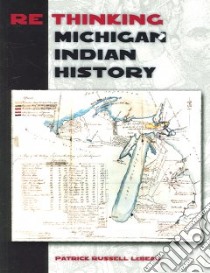Rethinking Michigan Indian History - 9780870137129
Un libro in lingua di Lebeau Patrick Russell edito da Michigan State Univ Pr, 2005
- € 26.80
- Il prezzo è variabile in funzione del cambio della valuta d’origine
Rethinking Michigan Indian History is a teaching tool that honors the Chippewa, Ottawa, and Potawatomi and the twelve federally recognized tribes of Michigan by recognizing their role and place in Michigan history--exploring what most people know (or do not know) about them.
Each lesson includes a background narrative, a set of hands-on activities, and provides easily understood and visual resources. Rethinking Michigan Indian History explores large issues of Indian stereotypes, the narrow focus on “great” Indian men, the lack of knowledge of treaties and treaty rights, and the role of maps to mislead or distort thinking about how history unfolds and the complexities of land ownership.
The lesson that explores Indian stereotypes identifies their existence not only in U.S. consumer culture but also in K-12 classrooms. The goal, however, is not to rebuke the consumer for having bought Big Chief Sugar or the teacher for having young students construct one-dimensional canoes, paddles, and Indians out of paper and glue but to use those activities as a demonstration of what most people know about Indians. From this point, a foundation of facts can begin to replace stereotypes in the learning process.
Demonstrating further how popular influences can control knowledge, the lesson on “great” Indian men shows that the popular preference for biographies of famous Indian warriors (Pontiac or Tecumseh) or individual women (Pocahontas or Sacagawea) narrows an understanding of Indians to symbolic representations and issues by ignoring their ongoing culture.
The lesson on Indian treaties and maps explains and visually shows the reason the Chippewa, Ottawa, and Potawatomi lived in Michigan in 1760 and live in Michigan today in roughly the same places. Treaties are explored in a manner that is understandable to fourth graders through adults, by showing where Indians lived, the treaty boundaries, and tribal land holdings. This lesson also shows Indian cartography concepts and how maps may be made.
What makes Rethinking Michigan Indian History unique and important is its non-confrontational and modular approach that challenges conventional thinking and teaching practices, while at the same time advocates change. The inclusion of graphic resources, handouts, and colorful maps makes this book necessary for the teacher, student, and the general reader who is interested in Michigan Indian history.
Informazioni bibliografiche
- Titolo del Libro in lingua: Rethinking Michigan Indian History
- Lingua: English
- Autore: Lebeau Patrick Russell
- Editore: Michigan State Univ Pr
- Collana: Michigan State Univ Pr (Paperback)
- Data di Pubblicazione: 30 Luglio '05
- Genere: HISTORY
- Argomenti : Indians of North America Michigan History Sources Indians of North America Michigan Historiography Indians of North America Study and teaching Michigan
- Pagine: 215
- Dimensioni mm: 273 x 215 x 12
- ISBN-10: 0870137123
- EAN-13: 9780870137129


